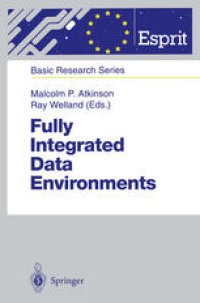
Ebook: Fully Integrated Data Environments: Persistent Programming Languages, Object Stores, and Programming Environments
- Tags: Database Management, Information Systems Applications (incl. Internet), Programming Languages Compilers Interpreters, Software Engineering
- Series: Esprit Basic Research Series
- Year: 2000
- Publisher: Springer-Verlag Berlin Heidelberg
- Edition: 1
- Language: English
- pdf
Research into Fully Integrated Data Environments (FIDE) has the goal of substantially improving the quality of application systems while reducing the cost of building and maintaining them. Application systems invariably involve the long-term storage of data over months or years. Much unnecessary complexity obstructs the construction of these systems when conventional databases, file systems, operating systems, communication systems, and programming languages are used. This complexity limits the sophistication of the systems that can be built, generates operational and usability problems, and deleteriously impacts both reliability and performance. This book reports on the work of researchers in the Esprit FIDE projects to design and develop a new integrated environment to support the construction and operation of such persistent application systems. It reports on the principles they employed to design it, the prototypes they built to test it, and their experience using it.
Research into Fully Integrated Data Environments (FIDE) has the goal of substantially improving the quality of application systems while reducing the cost of building and maintaining them. Application systems invariably involve the long-term storage of data over months or years. Much unnecessary complexity obstructs the construction of these systems when conventional databases, file systems, operating systems, communication systems, and programming languages are used. This complexity limits the sophistication of the systems that can be built, generates operational and usability problems, and deleteriously impacts both reliability and performance. This book reports on the work of researchers in the Esprit FIDE projects to design and develop a new integrated environment to support the construction and operation of such persistent application systems. It reports on the principles they employed to design it, the prototypes they built to test it, and their experience using it.
Research into Fully Integrated Data Environments (FIDE) has the goal of substantially improving the quality of application systems while reducing the cost of building and maintaining them. Application systems invariably involve the long-term storage of data over months or years. Much unnecessary complexity obstructs the construction of these systems when conventional databases, file systems, operating systems, communication systems, and programming languages are used. This complexity limits the sophistication of the systems that can be built, generates operational and usability problems, and deleteriously impacts both reliability and performance. This book reports on the work of researchers in the Esprit FIDE projects to design and develop a new integrated environment to support the construction and operation of such persistent application systems. It reports on the principles they employed to design it, the prototypes they built to test it, and their experience using it.
Content:
Front Matter....Pages i-x
Introduction....Pages 1-4
Persistent Languages: Introduction and Overview....Pages 5-8
Language Design: Introduction and State of the Art....Pages 9-12
Higher-Order Persistent Polymorphic Programming in Tycoon....Pages 13-59
Fibonacci: A Programming Language for Object Databases....Pages 60-97
The Napier88 Persistent Programming Language and Environment....Pages 98-154
Linguistic Reflection: Introduction and State of the Art....Pages 155-157
Type-Safe Linguistic Reflection: A Generator Technology....Pages 158-188
Type-Safe Linguistic Run-time Reflection A Practical Perspective....Pages 189-192
Type Systems: Introduction and State of the Art....Pages 193-195
A Calculus for Overloaded Functions with Subtyping....Pages 196-233
Protection in Persistent Object Systems....Pages 234-237
Subtyping and Assignment in Database Programming Languages....Pages 238-239
Bulk Types and Iterators: Introduction and State of the Art....Pages 241-244
The Joy of Sets....Pages 245-256
Bulk Types: Built-in or Add-On?....Pages 257-261
Extensible Objects for Database Evolution: Language Features and Implementation Issues....Pages 262-282
Concurrency and Transactions: Introduction and State of the Art....Pages 283-285
Specifying Flexible Concurrency Control Schemes: an Abstract Operational Approach....Pages 286-289
Persistent Threads....Pages 290-295
Persistent Support Systems: Introduction and Overview....Pages 297-302
Architecture and Abstract Machines: Introduction and State of the Art....Pages 303-309
Persistent Foundations for Scalable Multi-Paradigmal Systems....Pages 310-340
The DBPL Project: Advances in Modular Database Programming....Pages 341-345
The PamCase Machine....Pages 346-364
Tycoon: A Scalable and Interoperable Persistent System Environment....Pages 365-381
Object Store Design Introduction and State of the Art....Pages 383-386
An Open System Architecture for a Persistent Object Store....Pages 387-390
Overview of PIOS: a Physically Independent Object Server....Pages 391-426
Efficient Incremental Garbage Collection for Client-Server Object Database Systems....Pages 427-430
Towards a Unified Model of Untyped Object Stores: Experience with the Tycoon Store Protocol....Pages 431-433
Measuring Persistent Object Systems....Pages 434-438
Implementation Techniques: Introduction and State of the Art....Pages 439-441
Concurrent Shadow Paging in the Flask Architecture....Pages 442-445
Locking in OODBMS Clients Supporting Nested Transactions....Pages 446-461
Optimization of Nested Queries in Object Bases....Pages 462-479
Integrating Query and Program Optimization Using Persistent CPS Representations....Pages 481-495
An ad hoc Approach to the Implementation of Polymorphism....Pages 496-501
Using Persistent Languages: Introduction and Overview....Pages 502-504
Persistent Programming Environments: Introduction and State of the Art....Pages 505-506
Exploiting Persistent Linkage in Software Engineering Environments....Pages 507-510
Using Persistence Technology to Control Schema Evolution....Pages 511-514
Unifying Interaction with Persistent Data and Program....Pages 515-518
The Persistent Workshop — a Programming Environment for Napier88....Pages 519-522
The Glasgow Persistent Libraries....Pages 523-526
Visualising Persistent Stores....Pages 527-539
Data Modelling: Introduction and State of the Art....Pages 540-547
Application Development using Data Modelling....Pages 549-552
The STYLE Workbench: Systematics of Typed Language Environments....Pages 553-569
Using Extensible Grammars for Data Modelling....Pages 570-583
Interoperability: Introduction and State of the Art....Pages 584-598
Querying the File....Pages 599-601
Updating the File....Pages 602-620
Lean Languages and Models: Towards an Interoperable Kernel for Persistent Object Systems....Pages 621-622
Back Matter....Pages 623-627
....Pages 629-630